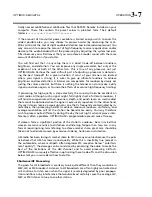
3-12
OPERATION ORBAN
MODEL
9400
be used to brighten the sound.
Group 3:
Radios with a response down 3dB at approximately 2 kHz, with a very
steep rolloff above that frequency. The steepness of the rolloff eliminates the
possibility of improving the audio through pre-emphasis. In our opinion, these
radios must be written off as producing hopelessly bad sound. Very few people
would enjoy listening to music on these radios
although they could be used for
listening to talk programs, or for repelling pigeons and muggers.
The vast majority of present-day radios are in the second and third categories. In all
three types of radio, bass performance is unpredictable from model to model. The
best-sounding “Group 1” AM receiver we know of is the Sony SRF-A100 AM stereo
radio (now discontinued), which can be switched between wideband and narrowband
operation. Use headphones, or drive an external amplifier and speaker with the Sony's
headphone output (its own tiny speakers cannot be used for reference purposes). A
representative good-sounding wideband mono radio is the General Electric Superadio.
As of the current writing, the number of AMAX radios available is very limited, with
the widest distribution being certain premium Delco radios that have been provided
with General Motors automobiles. In “Group 2,” we are fond of the Radio Shack MTA-
series of small table radios.
Be aware that many radios produce excessive distortion all by themselves, especially if
they are located near the transmitter. If the station monitor (driven through
OPTIMOD-AM's monitor rolloff filter) sounds clean but your radio audio is distorted,
don't trust the radio! If the General Manager's auto radio sounds distorted, he or she
should not jump to the conclusion that there is something wrong with the station or
with the engineer's ears.
Modulation Monitors
Many modulation monitors and RF amplifiers indicate higher modulation than the
transmitter is actually producing. This forces the engineer to reduce transmitter
modulation unnecessarily, which can cost you up to 3dB of loudness! It is
very
important
to be sure that your modulation monitor is accurately calibrated and that it
does not exhibit overshoot on program material. Several newer monitors are designed
for accurate pulse response without overshoot. Any of these monitors will enable you
to obtain the highest loudness achievable from your transmitter and antenna system.
If the monitor is used remotely, be sure that the RF amp doesn't overshoot. Overshoots
in RF amps have been observed to be as high as 3dB.
Monitor readings should be compared with an oscilloscope observing the modulated
RF envelope. If the monitor indicates 100% negative peaks when the oscilloscope
reveals no carrier pinch-off, suspect inaccuracy in the monitor.
More About Audio Processing
Psychoacoustic factors were carefully considered during the design and construction of
OPTIMOD-AM. The result is an audio processor that is easy to use (the
L
ESS
-M
ORE
control greatly simplifies setup) and that produces a sound that is remarkably free
from unwanted processing artifacts.
Summary of Contents for Optimod-AM 9400
Page 1: ...Operating Manual OPTIMOD AM 9400 Digital Audio Processor Version 1 2 Software...
Page 7: ...Operating Manual OPTIMOD AM 9400 Digital Audio Processor Version 1 2 Software...
Page 52: ......
Page 204: ......
Page 232: ......
Page 260: ......
Page 261: ...OPTIMOD AM DIGITAL TECHNICAL DATA 6 29...
Page 267: ...OPTIMOD AM DIGITAL TECHNICAL DATA 6 35 CPU Module...
Page 273: ...OPTIMOD AM DIGITAL TECHNICAL DATA 6 41 RS232 BOARD PARTS LOCATOR...
Page 275: ...OPTIMOD AM DIGITAL TECHNICAL DATA 6 43 8300 POWER SUPPLY PARTS LOCATOR...
Page 284: ...6 52 TECHNICAL DATA ORBAN MODEL 9400 DSP BOARD PARTS LOCATOR DRAWING 32170 000 14...
Page 292: ...6 60 TECHNICAL DATA ORBAN MODEL 9400 DISPLAY BOARD PARTS LOCATOR...
Page 293: ...OPTIMOD AM DIGITAL TECHNICAL DATA 6 61 DISPLAY BOARD...
















































